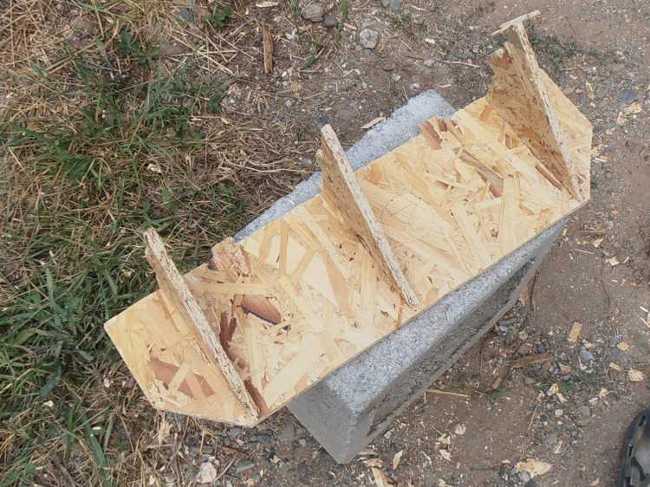Last year we built an attached shed on the north-west side of the house. The supply of materials in our town is limited so we had to make some choices about the materials for building the walls. We used tongue and groove paneling for most walls, but there is one wall in a concrete niche which was going to make attaching the paneling boards hard. I knew this so we bough some 5mm thick OSB / Aspenite boards. But why the heck we did buy whole 3 boards (1.44 x 2.88 m each)? I'll never know.
The result of the whole thing is that when the shed was finished, we were left with two and half boards of aspenite (OSB). The whole winter it was staying in the shed, occupying plenty of space. In the spring we started doing new shelves in the shed, pulling things out and in, and these large boards were troubling us all the time. So I decided to finally use them for something. So what did I came up with? More shed shelves!
The Design
OSB is not a robust material especially when it's so thin. You can't make a long shelve out of it and expect it to hold even its own weight without bending. Not to mention putting something over it. So you have to have two things in mind:
- The shelves shouldn't be too long.
- The shelves need supports. (When this is done properly they can be long in fact.)
And what's the most robust shape? The triangle. So I decided to build the shelves with triangle supports.
You can't expect 0.5cm thick OSB to attach well using only nails, screws or even glue. You also need some woodworking joints. So I decided to use droves and burrs. A board with droves on the back of the shelves would be used to attach them to the beams in the shed. Here below you can see pictures of the parts we used:
The Back Board

The droves in this board are used to attach the shelves using their burrs. The drove itself will be anchored to the wall using metal plates. You'll see this on the completed picture at the end.
From the picture above it seems that I have first measured all the burr positions and cut them before building the other parts. This is not true and not a good idea. OSB is not a material that allows precision work. So instead of trying to be exact, build your shelves first, then using them draw with a pencil the positions of the droves on the back board. It is what I did.
The best tool to cut such kind of droves is a chisel. I recommend you to buy a good chisel set like this one but it's expensive. A cheaper one like this
will also do the work. If you are building only once in a while you may prefer to buy a single cheap chisel from yoour local hardware store.
You also need a wooden mallet to work with the chisels. You can make a wooden mallet youself too, if you have some spare hardwood around.
Meanwhile, an assistant came to help me...

The Shelves
Our shed is long and narrow so I didn't want the shelves to stand too much from the beams. At the same time I want them to provide some space, so the trapezoid shape sounded to be a good option. So I cut out four shelves, all with droves for attaching the triangle supports and with burrs that will go in the back board droves. See below:

Then the supports:

The supports have burrs to go both into the shelves and into the back board. And when the supports fit in the shelves, here's the complete shelve:

You'd need some glue to make it stay stable. I even put small nails from the shelve to the support. This construction becomes really stable only after you attach it to the back board.
There's one imporptant thing to say here. When working with material like aspenite it's very hard to achieve exactly the same shapes of the different details. So instead of trying to be exact to the milimeter I numbered my parts. Shelves were numbered from 1 to 4 and I numbered the positions on the back board. In similar fashion I numbered my shelve supports as 1-1, 1-2, 1-3, 2-1, 2-1 etc, and numbered the droves in each shelve accordingly. So I knew which part where goes and any uneven burrs etc could fit.
The Complete Thing
OK, I know you want to see the whole thing. So here it is lying on the ground:

And here it is attached to our shed beams with metal plates (sorry it's not very bright in the shed):

Finally I used some nails and bare wire to add small fencing on each shelve. So if we decide to put some pickles there they won't drop down :)
And a final note: If you have not bought any materials yet, I recommend you to use plywood instead of OSB.
